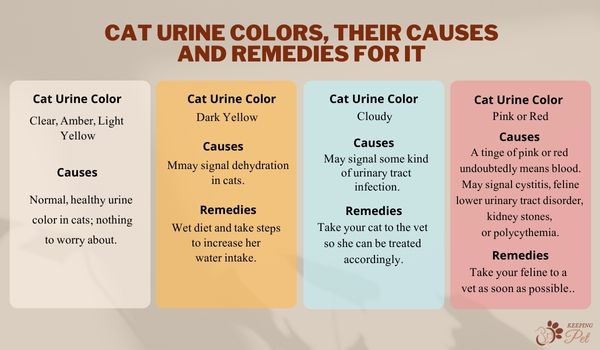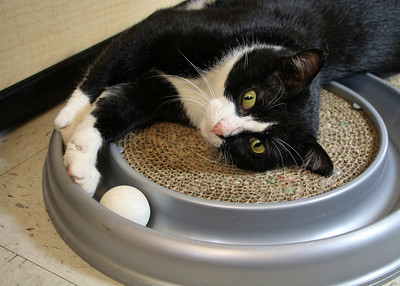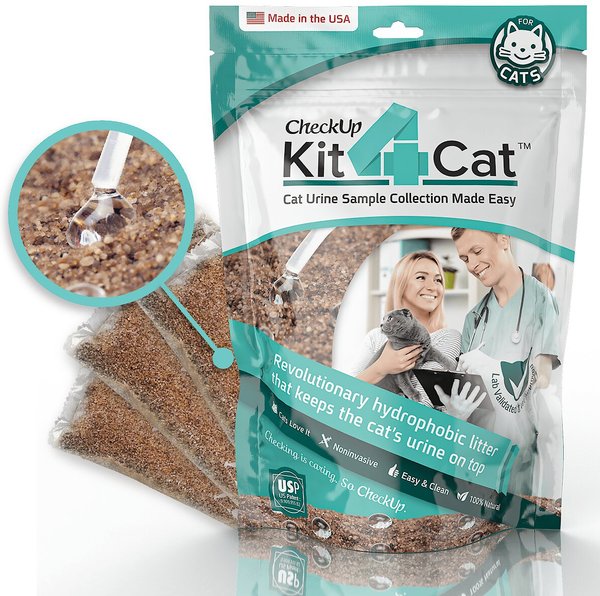A cat’s pee can tell a lot about your cat’s overall health. Although, with the use of modern-day smell-concealing litterboxes, it can be hard to observe your cat’s urine color or how it smells. But it is not impossible and with a little commitment and a conscious effort, you can learn a lot about your feline’s pee and what it tells you about its health.
In this article, we have explained in detail all the possible colors of a cat’s pee by adding a cat urine color chart, discussed the normal consistency and frequency of a cat’s urine, and what you can do to make your cat have a healthy excretory system.
So, without further ado, let’s check out all you need to know about your cat’s urine.
Cat Urine Color Chart
As mentioned above, we have included a cat urine color chart in this article so you can refer to it and get the necessary information related to your cat’s pee. It also includes the possible reasons and remedies so you can devise a suitable course of action if you ever notice your cat is unwell.
| Cat Urine Color | Causes | Remedies |
| Clear, Amber, Light Yellow | This is the normal, healthy urine color in cats, and there is nothing to worry about. | |
| Dark Yellow | It may signal dehydration in cats. | Feed it a wet diet and take steps to increase its water intake. |
| Cloudy | Cloudiness or having pus in it may signal some kind of urinary tract infection. | Take your cat to the vet so it can be treated accordingly. |
| Pink or Red | A tinge of pink or red undoubtedly means blood. This may signal cystitis, feline lower urinary tract disorder, kidney stones, or polycythemia. | Take your feline to a vet as soon as possible. Although these health issues are not life-threatening, they can be very uncomfortable for your pet. |

Unusual Urine Frequency
Whenever you notice any changes in the frequency of your cat’s urination, it is important to get it checked. If your cat is urinating more or less than usual, it may signal something of concern, so it is always better to get it checked by a vet. A normal, healthy cat will urinate twice a day on average. Anything more or less than this can be a sign of some health concern.
Decreased urination often occurs when there is some urethral blockage which usually occurs in male cats. Such a blockage becomes life-threatening within hours, so you shouldn’t take the matter lightly and immediately take your cat to be duly examined by a vet.
In contrast, an increase in the frequency of urination can be caused by diabetes, bladder infections, cystitis, and kidney diseases. It is also possible that your cat may be urinating more or less frequently when it is suffering from some behavioral problems. Whatever the reason may be, it is important to take it to a vet and get it checked to rule out the possibility of any serious health issues.
Unusual Urine Odor
Another sign that a cat may have some urinary issues is the odor of its urine. Cat’s urine, which has a more pungent scent than usual, can signify that it is suffering from some kind of bladder infection or cystitis.
In male cats, very strong or pungent-smelling urine may signal hormonal disorders or even tumors. If you smell something unusual or find your cat peeing outside its litterbox and in unusual places, you should take it to a vet and check her to rule out any life-threatening health issues.
What Can You Do to Ensure Your Cat’s Urinary System is Healthy?
Now that we have discussed in detail what factors may be causing abnormal urination in cats, it is also important to take a look at some remedies. There are certain tips you can apply to ensure your cat has a healthy urinary system. These steps are discussed below.
Disclaimer:
The information presented in this article is for educational purposes only. Our articles are vet-approved but much depends upon the history and condition of each individual cat. Always take your cat to a vet when you suspect an issue in your cat.
· Increase Water Intake
One of the most common causes behind a cat’s changing urine color can be decreased intake of water. So, to ensure your cat remains sufficiently hydrated, you should provide it with clean and fresh drinking water every day.
· Wet Food
Another way you can increase your cat’s water intake is by feeding it wet cat food rather than dry kibble. Wet food has higher water content, so it can help keep your cat well hydrated.
|
|
· Exercise:
Workout sessions or playing interactive games can also be effective in making your feline fellow thirsty. With rigorous physical activity, a cat would feel thirstier than usual and resultantly drink more water than she usually consumes.

How to Collect Cat Urine?
We know cats do not like to urinate anywhere outside their litterbox. Getting a urine sample of your feline friend can be tricky because most of the litterboxes these days are self-absorbing ones. But there are various sample collection kits available in the market that lets you collect your feline’s urine sample hassle-free.
|
|
To collect a urine sample from your cat, you can do the following;
- Cleaning: First things first, you should clean the cat’s litterbox tray and fill it with non-absorbing litter.
- Observation: After you clean the tray and pour non-absorbing litter into it, observe your cat and see when she uses the tray again.
- Collecting the Urine: After the cat urinates in the tray, use the pipette from the collection kit to collect urine.
- Storage: Once the sample is collected, transfer it to the special container provided in the kit and close the lid tightly.
- Testing: It is best to take the urine sample for testing within four hours of collecting the sample. But if you cannot manage to take the sample in the said time window, you can keep it in cool temperatures.
Other Anomalies to Look Out for
After studying the cat urine color chart in detail and learning about all the possible colors of a cat’s urine, we would also look at some other potential abnormalities in the urine. Some of the less commonly occurring abnormalities are;
Blood in Urine
One less common abnormality found in a cat’s urine can be blood in it. If your cat’s urine color changes from light yellow to brownish-red, this may be a signal of a medical condition called Hematuria.
A cat suffering from Hematuria may show signs of distress or crying when it urinates or may also miss using the litter box altogether. In such a scenario, you should immediately take your cat to a vet.
Clots or Crystals in Urine
Many a time, there can be blood clots or crystals found in urine. These can be a result of some inflammation or infection in the urinary tract. If left untreated, this can lead to obstruction of the urethra and make your cat unable to urinate. It can also become life-threatening and, thus, needs speedy treatment.
Pale or Colorless Urine
If you notice your cat’s pale or colorless urine, it may signal dilute urine, which can be a sign of kidney disease or diabetes.
FAQs Related to Cat Urine Color Chart
How to Tell If Your Cat’s Urine is Normal?
Knowing the color or odor of a cat’s urine can be tricky because modern-day litterboxes are self-absorbing and conceal the smell. But to get an idea that your cat’s urine is normal and it is overall healthy, you can monitor the frequency of its urination.
A healthy cat normally pees twice a day. Anything more or less than that can be a sign of some health issue.
What to Do If Your Cat’s Urine Has Blood in it?
If you find blood in your cat’s urine or its color has a tinge of reddish-brown, and if it is showing signs of distress or is crying, and is lethargic, you should immediately seek medical assistance and take your feline fellow to the nearest veterinary clinic. The vet will perform a complete physical checkup and may take the help of diagnostic tests such as a complete blood count and urinalysis.
Is There Any Difference in the Color of a Male and a Female Cat’s Urine?
No, there is no difference in the color of a cat’s urine based on its gender. A healthy male and a female cat have the same light yellow color of urine. There is no difference in the cat pee smell based on their gender as well.
Conclusion:
So we hope with our comprehensive guide about cat urine, you will be able to learn about what is normal and what is unusual in a cat’s urine. We have also included a cat urine color chart in this article so you can use it for reference whenever you want to check your cat’s urine. If you find your cat is urinating more or less than usual, has a more pungent smell, or is urinating outside of her litterbox, it may signal a health issue. Thus, it is important to keep a close eye on her and take her to a vet’s clinic if you notice something unusual.


